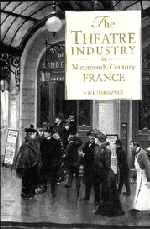Book contents
- Frontmatter
- Contents
- Chronology
- Introduction
- PART I THE AUDIENCES
- 1 Going to the theatre in the nineteenth century
- 2 The auditorium
- 3 Performance times – intervals – annual closures
- 4 First nights and previews
- 5 Order and disorder in the theatres
- 6 Applause and censure
- 7 The claque
- 8 Working-class audiences
- PART II THE ACTING PROFESSION
- PART III THE PROFESSION OF PLAYWRIGHT
- Notes
- Bibliography
- Guide to further reading
- Index
5 - Order and disorder in the theatres
Published online by Cambridge University Press: 07 December 2009
- Frontmatter
- Contents
- Chronology
- Introduction
- PART I THE AUDIENCES
- 1 Going to the theatre in the nineteenth century
- 2 The auditorium
- 3 Performance times – intervals – annual closures
- 4 First nights and previews
- 5 Order and disorder in the theatres
- 6 Applause and censure
- 7 The claque
- 8 Working-class audiences
- PART II THE ACTING PROFESSION
- PART III THE PROFESSION OF PLAYWRIGHT
- Notes
- Bibliography
- Guide to further reading
- Index
Summary
There was always a risk, before and during the French Revolution and even occasionally after it, for peaceful citizens visiting the theatre to find themselves embroiled in rough and violent incidents. Audiences were always noisy, apt to interrupt performances and now and then squabbles would lead to fighting, with the possibility of fatal consequences. Disorder was more likely to occur in the provinces than in the capital where, thanks largely to the stern edicts against most forms of misbehaviour, there were fewer instances of trouble-makers causing riots. Thus, a police ordinance of 2 April 1780 made it illegal ‘to shout or make any noise before the performance begins, and in the course of the play to blow whistles or boo, to put one's hat on one's head or interrupt the actors in any fashion and no matter on what pretext’. To ensure quiet behaviour, an earlier ordinance had established a military guard at the two Comediés, consisting originally of about thirty fusiliers, increased by 1788 to fifty-six at the Comedié-Française, sixty at the Opera, and sixty-seven at the Comédie-Italienne. They were stationed too at the minor theatres, as is evident from a passage in Mercier's Tableau de Paris:
When you arrive in front of a theatre, you perceive a company of guardsmen with shouldered arms. Crispin and Harlequin never appear on the boards until the grenadiers in their high hats have surrounded the building in which mirth and laughter will shortly resound. […]
- Type
- Chapter
- Information
- The Theatre Industry in Nineteenth-Century France , pp. 77 - 90Publisher: Cambridge University PressPrint publication year: 1993



